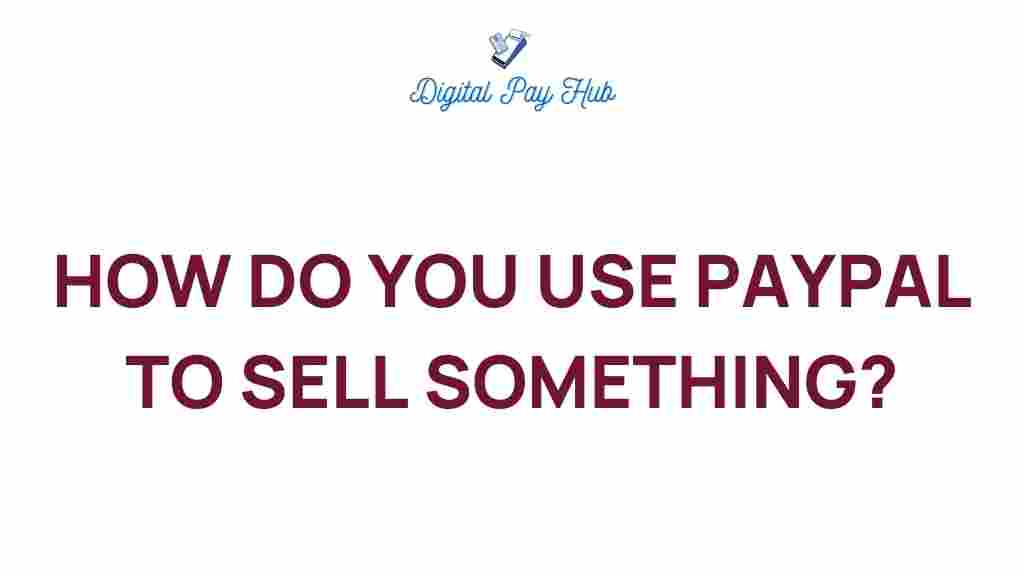Unlocking the Secrets: How to Use PayPal for Selling Success
In the world of e-commerce, utilizing the right tools can significantly impact your selling success. One of the most popular digital payment platforms is PayPal, which provides a seamless way for businesses and individual sellers to manage payment processing. This article will delve into the intricacies of using PayPal for selling online, focusing on features, fees, and tips for maximizing your selling potential. Whether you’re just starting or looking to improve your existing setup, understanding how to leverage PayPal can enhance your online marketplace experience.
Understanding PayPal and Its Benefits for Selling Online
PayPal is a widely recognized name in the realm of digital payments. It allows users to send and receive money securely over the internet. Here are the key benefits of using PayPal for your e-commerce business:
- Easy Integration: PayPal can be integrated with various e-commerce platforms like Shopify, WooCommerce, and Etsy.
- Buyer Protection: PayPal offers buyer protection, which can enhance customer trust and confidence.
- Merchant Tools: PayPal provides various tools for merchants, including invoicing, subscription management, and analytics.
- Global Reach: With PayPal, you can sell to customers around the world, as it supports multiple currencies.
Setting Up Your PayPal Account for E-Commerce
Getting started with PayPal is straightforward. Follow these steps to set up your account for selling online:
- Create a PayPal Business Account: Go to the PayPal website and select the option to sign up for a business account. This account type provides additional features tailored for sellers.
- Fill in Your Business Information: Enter your business name, email address, and other required details. Ensure that the information is accurate, as it will be used for transactions.
- Link Your Bank Account: For seamless transactions, link your bank account to your PayPal account. This allows you to transfer funds easily.
- Set Up Payment Methods: Configure the payment methods you want to accept, such as credit cards and bank transfers.
Once your account is set up, you can start accepting payments for your online sales.
Utilizing PayPal Merchant Tools for Selling Success
PayPal offers an array of merchant tools designed to help you manage your online business effectively. Here are some essential tools you should consider:
PayPal Buttons
Creating PayPal buttons allows you to add payment options directly to your website. You can customize buttons for different products or services:
- Add to Cart Buttons: Perfect for allowing customers to add items to their cart.
- Buy Now Buttons: Ideal for single purchases without a cart.
- Donation Buttons: Useful for nonprofits and charities.
Invoicing and Recurring Payments
If you provide services or have subscription-based offerings, you can use PayPal’s invoicing feature to send professional invoices to your clients. Additionally, setting up recurring payments can automate billing processes for subscriptions.
PayPal Checkout for E-Commerce Platforms
For those using platforms like Shopify or WooCommerce, integrating PayPal Checkout can enhance the checkout experience. It allows customers to complete their purchases quickly and securely.
Understanding PayPal Transaction Fees
While PayPal offers many advantages, it’s crucial to be aware of the associated transaction fees. Here’s a breakdown:
- Standard Transaction Fees: Typically, PayPal charges around 2.9% + $0.30 per transaction for domestic sales.
- International Transactions: Fees may increase for international sales due to currency conversion and cross-border fees.
- Micropayment Fees: For low-cost transactions, consider PayPal’s micropayment option, which offers a lower fee structure for transactions under $10.
To manage your finances effectively, keep track of these fees when pricing your products or services.
Ensuring Security with PayPal
Security is a major concern for online sellers and buyers. PayPal provides several layers of protection:
- Encryption: PayPal uses advanced encryption technology to protect sensitive information.
- Fraud Detection: PayPal employs sophisticated algorithms to detect suspicious activity.
- Buyer Protection: Customers can receive refunds if they do not receive their items or if the items are significantly different from the description.
By utilizing these security features, you can enhance customer confidence and encourage more transactions.
Troubleshooting Common PayPal Issues
While using PayPal is generally smooth, you may encounter some common issues. Here are troubleshooting tips for resolving them:
Payment Issues
If customers report problems with payments, consider the following:
- Check Account Status: Ensure your PayPal account is in good standing and not limited.
- Verify Payment Methods: Make sure that the payment methods linked to your account are valid and have sufficient funds.
Refunds and Disputes
In case of refunds or disputes, follow these steps:
- Review Transaction Details: Check the transaction history to understand the issue.
- Communicate with Customers: Reach out to affected customers to resolve their concerns directly.
- Utilize PayPal’s Resolution Center: Use this feature to address any disputes formally.
Tips for Maximizing Your Selling Success with PayPal
To enhance your e-commerce success using PayPal, consider these best practices:
- Set Clear Policies: Clearly outline your return and refund policies on your website.
- Optimized Checkout Experience: Ensure that the checkout process is user-friendly and quick.
- Promote Buyer Protection: Highlight PayPal’s buyer protection policies to instill confidence in your customers.
- Stay Informed: Regularly check for new features and updates from PayPal that could benefit your business.
Conclusion
As you embark on your journey in the world of e-commerce, mastering PayPal can be a game-changer for your selling success. By understanding how to set up your account, utilizing the available merchant tools, managing transaction fees, and ensuring security, you’ll be well-equipped to thrive in the online marketplace. Remember to stay proactive in troubleshooting issues and optimizing your selling strategies. For more resources on enhancing your online business, consider visiting this helpful guide. With the right approach and tools, your venture into selling online can be both rewarding and profitable.
This article is in the category Payments and created by DigitalPayHub Team
